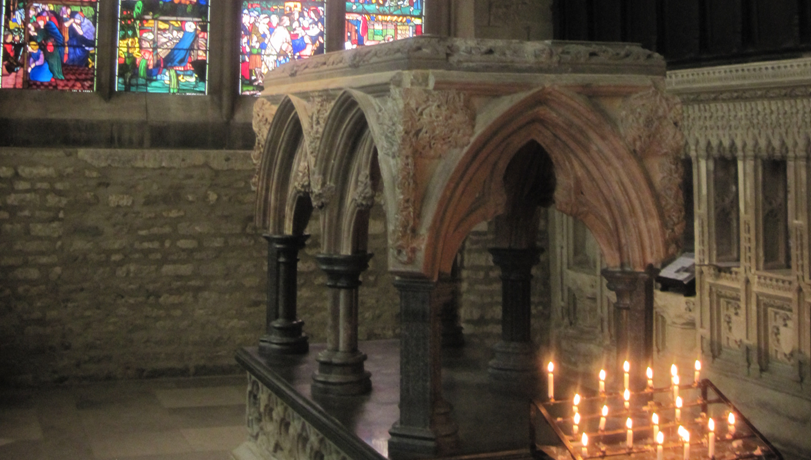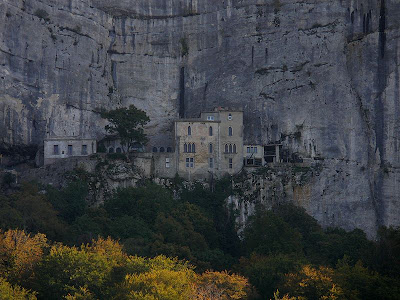Most notably, the shrines restored are at St. Alban's Cathedral of St. Alban the protomartyr of Britain, Durham Cathedral of St. Cuthbert, Oxford Cathedral of St. Frideswide, St. David's Cathedral in Wales, Chichester Cathedral of St. Richard, the shrine of Our Lady at Walsingham, Hereford Cathedral of St. Thomas, the shrine at Pennant Melangell in Wales, and York Minster Cathedral of St. William. The saints of those churches sustained their presence across the country even through the iconoclastic trials of the Edwardian reign in the 1540s. Their images survive in sculpture and stained glass, and their stories in cathedral libraries and local legends. A revival of the veneration of saints would echo all of human's need to first mourn for their dead and second to look to those who have died as role models...especially of the Christian Faith.
A pronounced return to the cults of Saints, both ancient and modern, would provide a stronger foundation for both congregational and personal devotion for members of the Church as well as providing another path to bring persons into the Body of Christ.
So how would saints be included in our everyday lives or worship? Many parishes have set up small altars dedicated to their patron or an image somewhere in the church where people can contemplate the actions and life of such a saint. Although images and relics have an historically awkward place in the Anglican Church as their veneration was banned in the 39 articles, the practice of placing candles before and image of a saint is not much different from placing flowers on the graves or by the images of our own dead.
Saints are those holy men and women who have led an exemplary Christian life. They were never seen as persons with divine status by any part of the medieval church. Rather, saints were venerated because they were seen as examples of how dedicated a Christian should be to Christ whether they were a pauper martyred as they "took up the cross" and refused to renounce Christ even unto death or a bishop who dedicated the whole of his episcopate to humbly serving the dispossessed of his diocese while his lordly colleagues enjoyed their episcopal palaces.
The Church owes much of her existence to these men and women who died for the faith or kept clean the Church of corruption. Today by placing a candle before the image or relic of a saint we are both thanking our mortal ancestors for giving us the Church and praying that we as Christians might be able to imitate the extreme dedication to Christ that these saints exercised.
Reviving the cults of saints also means that the Church should look for the saints who may not have been historically recognized as such. Samuel Seabury has made his way into the U.S. Episcopal Church's "Lesser Feasts and Fasts" book. But many lesser known priests and laypeople might deserve to be recognised as saints locally. After all, many of the saints of the middle ages were local religious or laypeople who were locally seen as holy people in their dedication to Christ for the variety of acts that they performed. Saints don't have to make miracles, at least not the kind of miracle where people are healed by touching the holy person's cloak or where a spring appears on the spot where the saint died. But men and women who dedicate their life to Christ replicate in our own power various acts of Christ. These acts are the miracles that we have to look for and aim to imitate ourselves. As St. David of Wales said on his deathbed "remember the little things that I did"...St. David, the 6th century bishop of Menevia, became the most venerated saint in all of Wales and remains so today.
Besides the devotion to saints within parishes, the saints are a way to bring parishes and dioceses to become more intimate with each other as One Holy Catholic and Apostolic Church though pilgrimage. Pilgrimage to particular churches or the cathedral of the diocese not only encourages a constant religious use of the church buildings but also associates churches with the holiness of a particular saint. The Greek Orthodox Church in my area of northern New Jersey brings bishops, priests, and lay people alike together on various saints feast days at churches dedicated to that saint. The Anglican Church can create a similar aura of diocesan unity through gathering for example at a church dedicated to St. Andrew on St. Andrew's day or by having an annual pilgrimage to the diocesan cathedral or to another parish church from the parishes of the diocese on the diocese's or cathedral's patronal feast day.
Parishes should encourage devotion to saints because saints provide examples of how a Christian life should look. The saints devoted their lives to Christ; their every action was based on Christ's own actions and commandments. The Church should encourage her flock to replicate the actions of those who have supported her in the past...so that she can flourish and continue to proclaim the risen Christ in the future.
Besides the devotion to saints within parishes, the saints are a way to bring parishes and dioceses to become more intimate with each other as One Holy Catholic and Apostolic Church though pilgrimage. Pilgrimage to particular churches or the cathedral of the diocese not only encourages a constant religious use of the church buildings but also associates churches with the holiness of a particular saint. The Greek Orthodox Church in my area of northern New Jersey brings bishops, priests, and lay people alike together on various saints feast days at churches dedicated to that saint. The Anglican Church can create a similar aura of diocesan unity through gathering for example at a church dedicated to St. Andrew on St. Andrew's day or by having an annual pilgrimage to the diocesan cathedral or to another parish church from the parishes of the diocese on the diocese's or cathedral's patronal feast day.
Parishes should encourage devotion to saints because saints provide examples of how a Christian life should look. The saints devoted their lives to Christ; their every action was based on Christ's own actions and commandments. The Church should encourage her flock to replicate the actions of those who have supported her in the past...so that she can flourish and continue to proclaim the risen Christ in the future.
 |
| Dedication of the rebuilt shrine of St. David, St. David's Cathedral, Wales. "Remember the little things that I did." |


